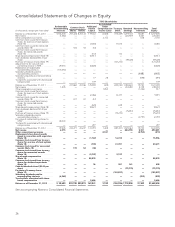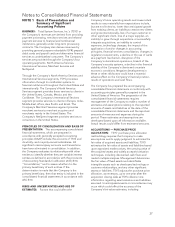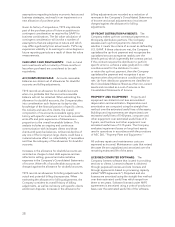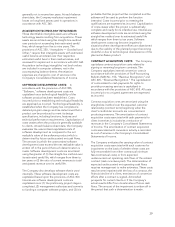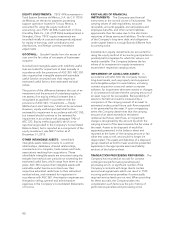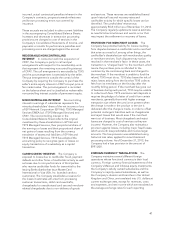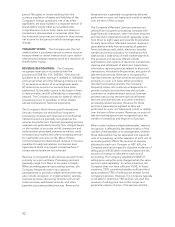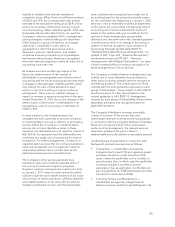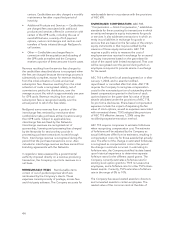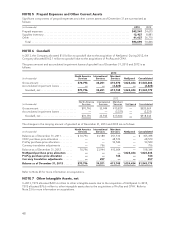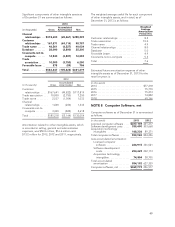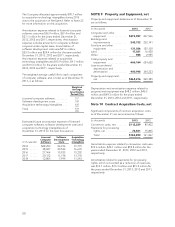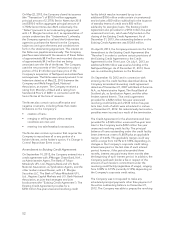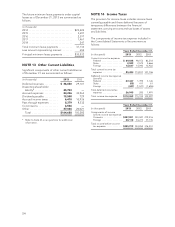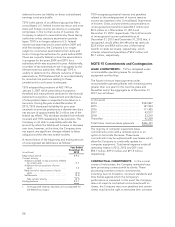NetSpend 2013 Annual Report Download - page 48
Download and view the complete annual report
Please find page 48 of the 2013 NetSpend annual report below. You can navigate through the pages in the report by either clicking on the pages listed below, or by using the keyword search tool below to find specific information within the annual report.The two-class method is an earnings allocation
method for computing EPS when an entity’s capital
structure includes two or more classes of common
stock or common stock and participating securities. It
determines EPS based on dividends declared on
common stock and participating securities and
participation rights of participating securities in any
undistributed earnings.
Basic EPS is calculated by dividing net income by the
weighted average number of common shares
outstanding during the period. Diluted EPS is
calculated to reflect the potential dilution that would
occur if stock options or other contracts to issue
common stock were exercised. Diluted EPS is
calculated by dividing net income by weighted
average common and common equivalent shares
outstanding. Common equivalent shares are
calculated using the treasury stock method.
RECLASSIFICATIONS: Certain reclassifications
have been made to the 2012 and 2011 financial
statements to conform to the presentation adopted
in 2013.
NOTE 2 Fair Value Measurement
ASC 820, “Fair Value Measurements and Disclosure,”
requires disclosure about how fair value is
determined for assets and liabilities and establishes a
hierarchy for which these assets and liabilities must
be grouped, based on significant level of inputs. The
three-tier fair value hierarchy, which prioritizes the
inputs used in the valuation methodologies, is as
follows:
Level 1 — Quoted prices for identical assets and
liabilities in active markets.
Level 2 — Observable inputs other than quoted
prices included in Level 1, such as quoted prices for
similar assets and liabilities in active markets, quoted
prices for identical or similar assets and liabilities in
markets that are not active, or other inputs that are
observable or can be corroborated by observable
market data.
Level 3 — Unobservable inputs for the asset or
liability.
Goodwill is assessed annually for impairment in the
second quarter of each year using fair value
measurement techniques. Specifically, goodwill
impairment is determined using a two-step test. The
first step of the goodwill impairment test is used to
identify potential impairment by comparing the fair
value of a reporting unit (RU) with its book value,
including goodwill. If the fair value of the RU exceeds
its book value, goodwill is considered not impaired
and the second step of the impairment test is
unnecessary. If the book value of the RU exceeds its
fair value, the second step of the goodwill
impairment test is performed to measure the amount
of impairment loss, if any. The second step of the
goodwill impairment test compares the implied fair
value of the RU’s goodwill with the book value of that
goodwill. If the book value of the RU’s goodwill
exceeds the implied fair value of that goodwill, an
impairment loss is recognized in an amount equal to
that excess. The fair value of the RU is allocated to all
of the assets and liabilities of that unit as if the RU
had been acquired in a business combination and the
fair value of the RU was the purchase price paid to
acquire the RU.
The estimate of fair value of the Company’s RUs is
determined using various valuation techniques,
including using an equally weighted combination of
the market approach and the income approach. The
market approach, which contains Level 2 inputs,
utilizes readily available market valuation multiples to
estimate fair value. The income approach is a
valuation technique that utilizes the discounted cash
flow (DCF) method, which includes Level 3 inputs.
Under the DCF method, the fair value of the RU
reflects the present value of the projected earnings
that will be generated by each RU after taking into
account the revenues and expenses associated with
the asset, the relative risk that the cash flows will
occur, the contribution of other assets, and an
appropriate discount rate to reflect the value of the
invested capital. Cash flows are estimated for future
periods based upon historical data and projections
by management.
As of December 31, 2013, the Company had
recorded goodwill in the amount of $1.5 billion. The
Company performed its annual impairment test of its
goodwill balances as of May 31, 2013, and this test
did not indicate any impairment. The fair value of the
RUs substantially exceeds the carrying value. Refer to
Note 6 for more information regarding goodwill.
The fair value of the Company’s long-term debt and
obligations under capital leases is not significantly
different from its carrying value.
NOTE 3 Relationships with Affiliated
Companies
The Company provides electronic payment
processing and other services to the Company’s
46


